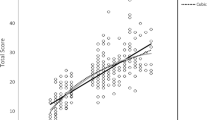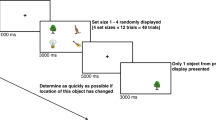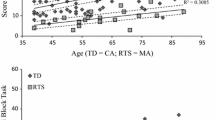Abstract
Working memory (WM), a key feature of the cognitive system, allows for maintaining and processing information simultaneously and in a controlled manner. WM processing continuously develops across childhood, with significant increases both in verbal and visuospatial WM. Verbal and visuospatial WM may show different developmental trajectories, as verbal (but not visuospatial) WM relies on internal verbal rehearsal, which is less developed in younger children. We examined complex VWM and VSWM performance in 125 younger (age 4–6 years) and 101 older (age 8–10 years) children. Latent multi-group modeling showed that (1) older children performed better on both verbal and visuospatial WM span tasks than younger children, (2) both age groups performed better on verbal than visuospatial WM, and (3) a model with two factors representing verbal and visuospatial WM fit the data better than a one-factor model. Importantly, the correlation between the two factors was significantly higher in younger than in older children, suggesting an age-related differentiation of verbal and spatial WM processing in middle childhood. Age-related differentiation is an important characteristic of cognitive functioning and thus the findings contribute to our general understanding of WM processing.

Similar content being viewed by others
Notes
Ethical approval was given by the research ethics committee of the University of Edinburgh, protocol number 111-1516/2.
One might criticize the fact that the two indicators for each WM domain were derived from the same task. Of course, two values derived from the same tasks should naturally correlate more strongly than different tasks. However, this has no influence on whether or not the four indicators (two VWM and two VSWM indicators) load on one common factor. Reliable tasks measuring the same underlying psychological construct have common variance over and above the task specific variance some indicators might share. Further, the question of one versus two factors is not central here. The distinction between two strongly correlating factors and one common factor is a cut off on a continuous scale. Rather the notable different correlations between VWM and VSWM for the younger and older children are theoretically important.
References
Alloway, T. P., Gathercole, S. E., Adams, A.-M., Willis, C., Eaglen, R., & Lamont, E. (2005). Working memory and phonological awareness as predictors of progress toward early learning goals at school entry. British Journal of Developmental Psychology, 23, 417–426. https://doi.org/10.1348/026151005X26804.
Alloway, T. P., Gathercole, S. E., Kirkwood, H., & Elliott, J. (2009). The cognitive and behavioral characteristics of children with low working memory. Child Development, 80, 606–621. https://doi.org/10.1111/j.1467-8624.2009.01282.x.
Alloway, T. P., Gathercole, S. E., & Pickering, S. J. (2006). Verbal and visuospatial short-term and working memory in children: Are they separable? Child Development, 77, 1698–1716. https://doi.org/10.1111/j.1467-8624.2006.00968.x.
Alloway, T. P., Gathercole, S. E., Willis, C., & Adams, A. M. (2004). A structural analysis of working memory and related cognitive skills in young children. Journal of Experimental Child Psychology, 87, 85–106. https://doi.org/10.1016/j.jecp.2003.10.002.
Baddeley, A. D. (2000). The episodic buffer: A new component of working memory? Trends in Cognitive Science, 4, 417–423. https://doi.org/10.1016/S1364-6613(00)01538-2.
Baddeley, A. D., & Hitch, G. J. (1994). Developments in the concept of working memory. Neuropsychology, 8, 485–493. https://doi.org/10.1037/0894-4105.8.4.485.
Barrouillet, P., & Camos, V. (2012). As time goes by: Temporal constraints in working memory. Current Directions in Psychological Science, 21, 413–419. https://doi.org/10.1177/0963721412459513.
Barrouillet, P., & Camos, V. (2014). On the proper reading of the TBRS model: Reply to Oberauer and Lewandowsky (2014). Frontiers in Psychology, 5, 1331. https://doi.org/10.3389/fpsyg.2014.01331.
Beauducel, A., & Wittmann, W. W. (2005). Simulation study on fit indexes in CFA based on data with slightly distorted simple structure. Structural Equation Modeling, 12, 41–75. https://doi.org/10.1207/s15328007sem1201_3.
Cheung, G. W., & Rensvold, R. B. (2002). Evaluating goodness-of-fit indexes for testing measurement invariance. Structural Equation Modeling, 9, 233–255. https://doi.org/10.1207/S15328007SEM0902_5.
Cowan, N. (2014). Working memory underpins cognitive development, learning, and education. Educational Psychology Review, 26, 197–223. https://doi.org/10.1007/s10648-013-9246-y.
Cowan, N., Cartwright, C., Winterowd, C., & Sherk, M. (1987). An adult model of preschool children’s speech memory. Memory & Cognition, 15, 511–517. https://doi.org/10.3758/BF03198385.
Cuvo, A. J. (1975). Developmental differences in rehearsal and free recall. Journal of Experimental Child Psychology, 19, 265–278. https://doi.org/10.1016/0022-0965(75)90090-9.
Flavell, J. H., Beach, D. R., & Chinsky, J. M. (1966). Spontaneous verbal rehearsal in a memory task as a function of age. Child Development, 37(2), 283–299. https://doi.org/10.2307/1126804.
Gathercole, S. E., Pickering, S. J., Ambridge, B., & Wearing, H. (2004). The structure of working memory from 4 to 15 years of age. Developmental Psychology, 40, 177–190. https://doi.org/10.1037/0012-1649.40.2.177.
Gray, S., Green, S., Alt, M., Hogan, T. P., Kuo, T., Brinkley, S., & Cowan, N. (2017). The structure of working memory in young children and its relation to intelligence. Journal of Memory and Language, 92, 183–201. https://doi.org/10.1016/j.jml.2016.06.004.
Hitch, G. J., Halliday, M. S., & Littler, J. E. (1993). Development of memory span for spoken words: The role of rehearsal and item identification processes. British Journal of Developmental Psychology, 11, 159–169. https://doi.org/10.1111/j.2044-835X.1993.tb00595.x.
Hitch, G., Halliday, M., Schaafstal, A., & Heffernan, T. (1991). Speech, inner speech, and the development of short-term-memory—Effects. Journal of Experimental Child Psychology, 51(2), 220–234. https://doi.org/10.1016/0022-0965(91)90033-O.
Jarrold, C., & Towse, J. N. (2006). Individual differences in working memory. Neuroscience, 139, 39–50. https://doi.org/10.1016/j.neuroscience.2005.07.002.
Jarvis, H. L., & Gathercole, S. E. (2003). Verbal and nonverbal working memory and achievements on national curriculum tests at 11 and 14 years of age. Educational and Child Psychology, 20, 123–140.
Kane, M. J., Hambrick, D. Z., Tuholski, S. W., Wilhelm, O., Payne, T. W., & Engle, R. W. (2004). The generality of working-memory capacity: A latent-variable approach to verbal and visuo-spatial memory span and reasoning. Journal of Experimental Psychology: General, 133, 189–217. https://doi.org/10.1037/0096-3445.133.2.189.
Karbach, J., & Kray, J. (2007). Developmental changes in switching between mental task sets: The influence of verbal labeling in childhood. Journal of Cognition and Development, 8, 205–236. https://doi.org/10.1080/15248370701202430.
Kuperman, V., Stadthagen-Gonzalez, H., & Brysbaert, M. (2012). Age-of-acquisition ratings for 30 thousand English words. Behavior Research Methods, 44, 978–990. https://doi.org/10.3758/s13428-013-0348-8.
Michalczyk, K., Malstädt, N., Worgt, M., Könen, T., & Hasselhorn, M. (2013). Age differences and measurement invariance of working memory in 5- to 12-year-old children. European Journal of Psychological Assessment, 29(3), 220–229. https://doi.org/10.1027/1015-5759/a000149.
Oberauer, K. (2009). Design for a working memory. Psychology of Learning and Motivation, 51, 45–100. https://doi.org/10.1016/S0079-7421(09)51002-X.
Oberauer, K., & Lewandowsky, S. (2013). Evidence against decay in verbal working memory. Journal of Experimental Psychology: General, 142, 380–411. https://doi.org/10.1037/a0029588.
Ornstein, P. A., Naus, M. J., & Stone, B. P. (1977). Rehearsal training and development differences in memory. Developmental Psychology, 13, 15–24. https://doi.org/10.1037/0012-1649.13.1.15.
Park, D. C., Lautenschlager, G., Hedden, T., Davidson, N., Smith, A. D., & Smith, P. K. (2002). Models of visuospatial and verbal memory across the adult life span. Psychology and Aging, 17, 299–320. https://doi.org/10.1037/0882-7974.17.2.299.
Pickering, S. J., Gathercole, S. E., & Peaker, M. (1998). Verbal and visuo-spatial short-term memory in children: Evidence for common and distinct mechanisms. Memory and Cognition, 26, 1117–1130. https://doi.org/10.3758/bf03201189.
Roebers, C. M., & Zoelch, C. (2005). Erfassung und Struktur des phonologischen und visuell-räumlichen Arbeitsgedächtnisses bei 4-jährigen Kindern. Zeitschrift für Entwicklungspsychologie und Pädagogische Psychologie, 37, 113–121. https://doi.org/10.1026/0049-8637.37.3.113.
Schneider, W., Eschmann, A., & Zuccolotto, A. (2002). E-Prime user’s guide. Pittsburgh, PA: Psychology Software Tools.
Steenkamp, J.-B. E. M., & Baumgartner, H. (1998). Assessing measurement invariance in cross-national consumer research. The Journal of Consumer Research, 25, 78–107. https://doi.org/10.1086/209528.
Studer-Luethi, B., Kodzhabashev, S., Hogrefe, A., & Perrig, W. J. (2015). BrainTwister2—An extended collection of cognitive training tasks. Fachstelle für Lernen und Gedächtnis: Universität Bern.
Titz, C., & Karbach, J. (2014). Working memory and executive functions: Effects of training on academic achievement. Psychological Research, 78, 852–868. https://doi.org/10.1007/s00426-013-0537-1.
Vallar, G., & Papagno, C. (2002). Neuropsychological impairments of verbal short-term memory. In M. Kopelman, A. D. Baddeley, & B. Wilson (Eds.), Handbook of neuropsychology (2nd ed., pp. 249–270). Chichester: Wiley.
Vergauwe, E., Barrouillet, P., & Camos, V. (2010). Do mental processes share a domain-general resource? Psychological Science, 21, 384–390. https://doi.org/10.1177/0956797610361340.
Wilhelm, O., Hildebrandt, A., & Oberauer, K. (2013). What is working memory, and how can we measure it? Frontiers in Psychology, 4, 433. https://doi.org/10.3389/fpsyg.2013.00433.
Acknowledgements
This work was supported by joint grants from the UK Economic and Social Research Council (ESRC, ES/N018877/1) and the German Research Foundation (DFG, KA 3216/2-1). We thank A. Cloes, G. Schaarschmidt, M. Hansmann, R. Sperlich, A. Hall, J. Middleton, S. Ju, and C. Serrano for their help with testing, KoWo - Kommunale Wohnungsgesellschaft mbH Erfurt for providing a test room, and the children and their parents for their participation.
Author information
Authors and Affiliations
Corresponding author
Additional information
Publisher's Note
Springer Nature remains neutral with regard to jurisdictional claims in published maps and institutional affiliations.
Electronic supplementary material
Below is the link to the electronic supplementary material.
Rights and permissions
About this article
Cite this article
Buttelmann, F., Könen, T., Hadley, L.V. et al. Age-related differentiation in verbal and visuospatial working memory processing in childhood. Psychological Research 84, 2354–2360 (2020). https://doi.org/10.1007/s00426-019-01219-w
Received:
Accepted:
Published:
Issue Date:
DOI: https://doi.org/10.1007/s00426-019-01219-w




